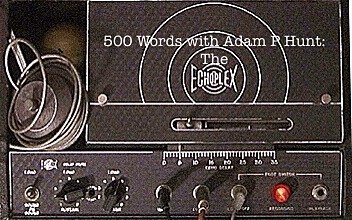-
11Mar2015
- share:
500 Words with Adam P Hunt- The Echoplex

500 Words The Echoplex
As an experiment turn on your amp then turn off every delay, echo, and reverb unit that are part of your signal chain. Okay, cool, now strum a few chords. Kind of “blah” sounding, right?
Delay, echo, and reverb have been part of popular music for so long it’s almost impossible to imagine listing to music without these effects.
At one point the only way to achieve that “depth” or “resonance” was to build a massive opera hall and as grand as those thing are they aren’t very portable.
One of the fist effects that guitar makers incorporated into amp designs was the tremolo (developed by DeArmond) the vibrato (originally a Danelectro design) and later, spring reverb units that were (designed by Laurens Hammond of Hammond Organ).
One of the first pieces of early rock ‘n’ roll featuring “echo” was “Movin’ N Grovin “ by Duane Eddy. Unfortunately when Eddy went to record this song the Phoenix studio didn’t have an echo chamber so Eddy’s co-writer, Lee Hazlewood bought a 2,000 gallon water storage tank to help create a natural echo.
Another person that helped popularize rich, echo sounds was Les Paul.
Arguably lugging a 2000 gallon water storage tank is only slightly more difficult to move around a Leslie rotating speaker cabinet and neither of those things would easily fit into a Volkswagen Beetle.
One of the first tape echo units was the EchoSonic guitar amp made by Ray Butts in 1952. Like Standel amps, Butts’ EchoSonic quickly became a “must have” item for country and rockabilly players. But like Standel amps demand out paced Ray’s ability to keep up with demand.
The first, portable, commercially available tape echo was the Echoplex designed by Ray Butts in the fifties but the first portable version was deigned by Don Dixon and refined further by Mix Battle in 1961.
In 1962 the Dixon and Battle’s paten was bought by Market Electronics from Cleveland Ohio and was distributed by Maestro. Battle and Dixon were kept onboard as consultants.
Eventually Harris-Teller of Chicago took over production from Market Electronics where it became known as the EP-1.
A later EP-2 version was developed that addressed many of the reliability issues found in the EP-1 and finally two solid state versions called the EP-3 and EP-4 were introduced.
By 1991 the mechanical, tape echo machines were eventually discontinued in favor of the Oberheim Echoplex Digital Pro.
The Exhoplex is far from extinct and it has spawned many offspring including the Fulltone Tube Tape Echo and the Xotic EP Booster, a boost pedal based on the Echoplex EP-3 preamp design.
As beautiful sounding as Echoplex units are they aren’t the most reliable of systems and by the late seventies tinkerers started working on smaller echo units with greater dependability than their tape based predecessors.
While the introduction of the Boss DM-2 didn’t exactly kill the Echoplex it dealt the again Echoplex a near fatal blow.
Whether you like a little “slap back” or a Hawkwind space opera a little echo can help fill up your sound.
Adam P Hunt is a freelance writer who has previously written for The Library Journal and Premier Guitar Magazine. We are so happy to have him join us here at Guitar Radio Show.com.
